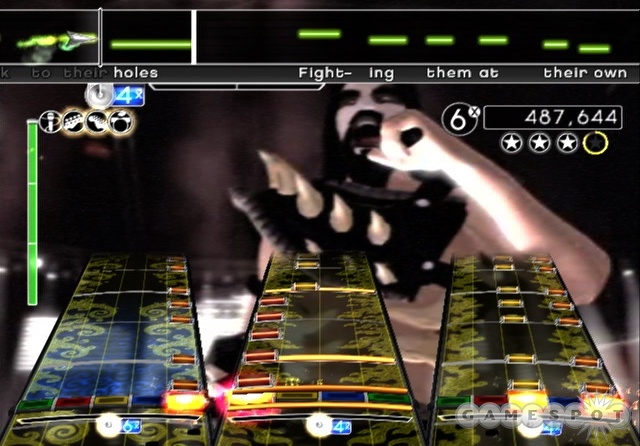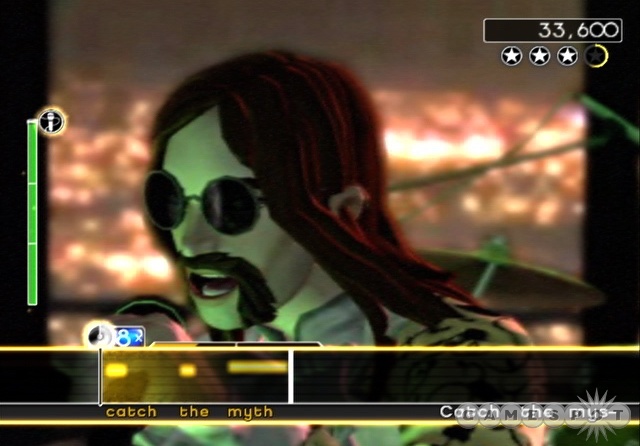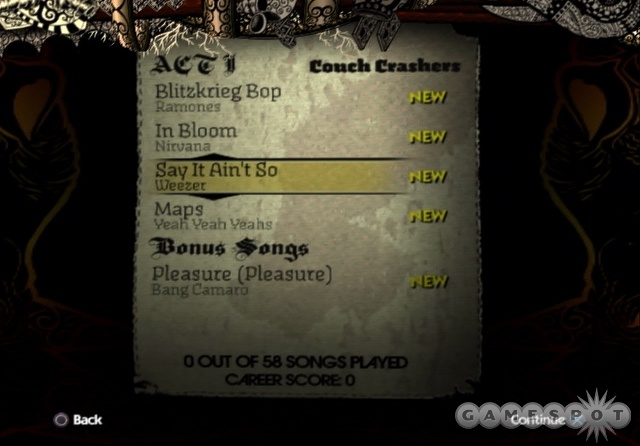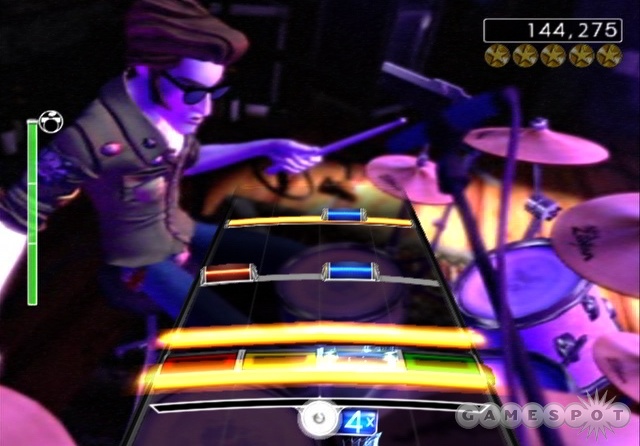Released last month on the Xbox 360 and PlayStation 3, Rock Band was a revelation for rhythm game fans everywhere. By taking the concept laid down by Guitar Hero then multiplying it by a factor of drums and vocals, developer Harmonix essentially set the bar for multiplayer rhythm gaming. Now, Rock Band comes to the PlayStation 2, albeit without quite the wow factor of the previous iterations. The PS2 game includes the same collection of hardware as the last release, as well as the same core gameplay design. However, several key modes are missing--modes that made a big difference in the previous releases and are greatly missed in this one. By all accounts, Rock Band is still a lot of fun on the PS2--it's just nowhere near the ideal version of the experience.

Before we launch into the big recounting for the uninitiated of what Rock Band is, let's just quickly address exactly what the key changes in the PS2 version are for those just looking for differences. The main alteration was to the selection of game modes, of which there are decidedly fewer in this iteration. Online play of any sort has been taken out, along with the ability to download additional content. Not that the PS2 really has any reasonable way of storing downloadable content, but the game disc doesn't include any of the premium downloadable songs that have since been made available on the Xbox 360 and PlayStation 3 either. Customization features are also absent, meaning you don't have the ability to create your own rocker. The game simply uses a smattering of default characters through each song, which is kind of a bummer because creating your own band members and customizing them as you pleased was a big draw of the experience.
Another big draw was the band world tour, the cooperative career mode. A version of that mode still exists here, but it's just a basic set list, à la Guitar Hero's career progression or Rock Band's single-player career. All the added elements, from traveling between venues and cities and earning stars and fans to eventually working your way into the hall of fame, are gone. At least there is some semblance of a way to play a career with your friends, but this version of it is a great deal less exciting.
As much as that all sucks, none of that robs the game of its greatest strength: its gameplay. In a sense, Rock Band is a little like three distinct games built into one. First, there's the guitar game, which lets you play approximately the same sort of game as Guitar Hero on guitar and bass, but with a few key differences. For one, the guitar itself is built quite differently from the Guitar Hero guitars. It's bigger, with a longer neck, and its body feels more solid. The fret buttons are larger, and are flush against the neck of the guitar, and there is a second set of narrower fret buttons all the way down the neck that you can tap on for solos. The guitar even comes with a built-in effects switcher, which puts effects like echo, flange, and wah-wah over the in-game guitar track.
The actual guitar gameplay isn't much different from Guitar Hero, with you strumming along and periodically tilting the guitar to engage "overdrive" (the game's equivalent of star power), but a couple of neat twists do add some flavor. For one thing, solos are given their own scoring section in each song, and the game tracks the percentage of notes hit during a solo. The higher the percentage, the higher the score bonus you get at the end of the solo.
The guitar game is of good quality, though a couple of things about it might drive a few longtime Guitar Hero fans batty. For one, the difficulty of the game is a good deal less challenging than what the hardcore Guitar Hero fan base is probably accustomed to at this point. The goal with Rock Band seems to be more about bringing in newcomers, so as a result, the difficulty level sits somewhere between Guitar Hero and Guitar Hero II overall. Not a bad thing if Guitar Hero III gave you conniption fits, but potentially less exciting for some of the hardcore guitar gamers out there. Also of note is that the note charts for guitar are handled a bit differently, with notes that can be pulled off via hammer-ons and pull-offs appearing as half-sized notes on the chart. It's not quite as easy to see these notes as in, say, Guitar Hero III, so you might end up screwing up a few solos until you get used to this new methodology.
Lastly is the guitar itself. It's a good guitar, but it does some things differently than the standard GH model guitars. The strummer doesn't click when you strum up or down, and the fret buttons seem a bit less forgiving in terms of timing in solos and other, tougher sections. It's not that it's bad or wrong--it's just different, and it takes some getting used to. Also, you're not going to get a ton of mileage out of things like the second set of buttons and the effects switch. Most people will probably forget the switch is even there until they accidentally turn on wah-wah, and sliding down to the second button set is a bit vexing to do just as you're about to head straight into a solo, since it takes a while to get accustomed both to the smaller buttons and to finding exactly where they are on the neck without staring at the guitar for a few seconds. Fake-guitar virtuosos will probably dig it, but most people will likely stick to the standard method.
Next there's the singing game, which closely emulates the mechanics of Karaoke Revolution and SingStar, but, again, with a couple of specific differences. You sing along as the lyrics display on the screen, trying to match your vocal pitch to the meter that moves up and down with the original vocal track. The key thing about singing is that the number of sections where a singer actually gets to do his or her thing is somewhat limited. But even those down moments aren't left for pure silence. Sometimes the vocal area of the screen will turn yellow, indicating for you to "make some noise," which then engages overdrive. There are also sections where you can simply tap the microphone to the rhythm of the song to get a tambourine or cowbell section going.
Beyond these wrinkles, the core of the vocal game design is to just sing, sing, sing...and occasionally rap. If there is any complaint to be made about the vocals, it's that it doesn't leave a lot of room for interpretation. On the higher difficulty settings, the game is extremely intent on you hitting the mapped pitches as closely as possible, even in situations where it seems like the mapped pitches aren't quite exact to what the original vocalist is doing. The same goes for the timing of each word. In some songs vocalists will trail off, but you can't really do that and still get the max score, which makes the vocals feel a bit robotic. Still, most vocal pieces are quite fun regardless, and in a nice touch to help middling vocalists everywhere, you can adjust the original vocal track volume via the controller as you play, so you can use it for as much or as little of a guide as you prefer.

Finally there are the drums, easily the most intense and enjoyable instrument of the bunch. The kit consists of a collection of four color-coded pads and a kick pedal, along with a pair of drum sticks. There's really no reference point for the drums portion of the game except for, well, real drums. You hit the pads in time as you would with a realistic drum kit, and on expert, the game practically maps out each song's drum part note for note. Make no mistake: When you are playing on expert, you are playing the drums. If you can do well on expert, you can probably pull out a decent beat on a real drum set at will. The good news for novices is that easy difficulty does a pretty good job of easing you into the act of drumming. The number of notes is much more limited, kick pedal usage is rare, and drum fills are eased back quite a bit.
Speaking of fills, one really cool thing about the drum portion of the game is that it allows for some improvisation. The way the drums handle overdrive is to give you some blocked-out sections where you can just bust out any kind of drum fill you want. The pads act as a snare, two tom-toms, and a crash cymbal. Go nuts, but just be sure you hit the last crash cymbal note at the end of the fill, at which point you will engage overdrive.
All of this hardware is of the same basic make and quality as in the previous versions of the game. In fact, the PS2 version actually comes with the exact same hardware that the PS3 version comes with, wireless guitar and all. So if you are planning on buying a PS3 at some point, you could get this version and then just buy the new game disc without rebuying hardware down the road. Because the game only comes with one guitar--and MTV/EA aren't selling separate guitars yet--you'll be pleased to know that if you already own a Guitar Hero guitar for the PS2, you can simply use that one.

You might be wondering exactly how reliable the hardware is, given the reports out about issues surrounding each of the different instruments in the initial run of the Xbox 360 and PS3 releases. Harmonix has come out and said that the initial run of instruments had some problems. However, it's swearing up and down that any hardware out on the market past the initial run should be problem free. For what it's worth, our hardware that came with the PS2 version of the game came out of the box unbroken across the board.
That covers all the technicals of the instrumental gameplay, but none of that quite emphasizes how excellent the game is at emulating the act of band play. By themselves, each instrument is basically fun, but when you get four people together playing at once, something spectacular emerges. Part of it is the way in which scoring has been designed for cooperative play. Overdrive can be turned on by anyone, but the more people you have in overdrive at once, the higher the score bonuses. By the same token, if one person in your band fails out of a song, another can simply engage overdrive (provided enough is stored up at that point) and come to the rescue, bringing the player back into the fold. But it goes beyond even the scoring mechanics. There's just something intangibly brilliant about the way having everyone play together feels. For instance, because the drums emulate the real-life instrument so closely, having a good drummer is paramount for success. If your drummer gets off beat, it can badly screw everyone up. Along the same lines, when your drummer is in a solid groove and the rest of the band is able to lock into that groove, the feeling that you're actually performing a song as opposed to simulating one is palpable, and it is quite the exhilarating feeling.
The game's song list goes a long way toward making that multiplayer even more enjoyable. Though the game includes only 45 licensed songs (along with 13 bonus tracks from lesser-known bands), many of these 45 are big-name tracks that are immediately recognizable and span multiple rock genres. Alternative rock fans will find such '90s delights as Weezer's "Say It Ain't So," Smashing Pumpkins' "Cherub Rock," and Nirvana's "In Bloom." Modern rockers will find The Killers' "When You Were Young," Foo Fighters' "Learn to Fly," and Yeah Yeah Yeahs' "Maps." Classic rock fans will delight in being able to rock their way through Black Sabbath's "Paranoid," The Rolling Stones' "Gimme Shelter," and KISS's "Detroit Rock City." Other, less specifically denominational yet altogether awesome songs include The Ramones' "Blitzkrieg Bop," Rush's "Tom Sawyer," and Metallica's "Enter Sandman."
The vast majority of these songs are original tracks from the artists, with only a few covers scattered throughout the tracklist. Only a few of the covers really stick out much. The Geddy Lee on "Tom Sawyer" is a bit overblown, and the singer of Mountain's "Mississippi Queen" is a bit odd sounding as well. But by and large, the covers blend in nicely, and whoever did the vocals for Steven Tyler and Bruce Dickinson on the Aerosmith and Iron Maiden songs respectively deserve some kind of vocalist soundalike merit badge.
The only real problem with the tracklist is that some of the songs aren't the kind of immediately recognizable stuff you would expect in a game that's all about a bunch of people getting together and making elaborate band karaoke. Quick, off the top of your head, immediately think up the melody to The Police's "Next to You," or Molly Hatchet's "Flirtin' With Disaster." None of these songs are unpleasant to play or anything, but they don't quite fit into the scheme of songs anyone can just pick up and rock to, especially on vocals. Heck, just about anyone can probably whine their way through "Cherub Rock" or snarl through "Enter Sandman" on the lower difficulty levels. But Aerosmith's "Train Kept a Rollin'"? Maybe not so much, but perhaps that just depends on you and your friends' personal tastes in music.
In terms of the available feature set, we've already run down what the game doesn't include. You can play solo in quick play or in one of the three solo career modes: one for guitar, one for vocals, and one for drums. These all follow the basic formula laid down by Guitar Hero, with tiers that unlock in order of increasing difficulty. As mentioned previously, there is also the version of the band world tour, though again, it's just the same sort of progression as the single-player career mode. Additionally, there is a cooperative quick play mode, as well as a couple of competitive modes, such as a basic score duel (same instrument, same difficulty, play the entire song) and a tug-of-war mode (same instrument, any difficulty level, trade off sections of the song, try to win the crowd over to your side by performing the best). These modes are about as enjoyable as Guitar Hero III's multiplayer component (minus the online), so if you dug that, you'll definitely dig this stuff.

One of Rock Band's greatest strengths on the Xbox 360 and PS3 was its presentation, and a surprising amount of that presentational quality has made it to this version. The lack of character customization does make the game feel a great deal less dynamic, but the character modeling and animation still look great, and a lot of the visual filters the other versions had are on display here. Granted, it almost seems like the game is just running full-motion video of characters from the PS3 or 360 versions playing because the game uses a lot of the same band members over and over again. But either way, the background stuff still looks great, especially if you're running an HD display and playing with progressive scan turned on. If there's any flaw to be found in the visuals at all, it's that the notes on the note charts are a little on the small side. It's not a big deal in one- or two-player play, but when you have both guitars and drums going at once, it can sometimes be tough to make out whether you've hit a note or not. This is especially true of the PS2 version, where the note hits are even less definitively visible, especially with the drums.
In the end, it's a shame that the PS2 version of Rock Band can't quite measure up to the previous versions of the game, but it's still a lot of fun. The gameplay pops just about as well as it did on the 360 and PS3, and when playing with friends, the multiplayer experience is second to none. The only real issue here is the game's value proposition. It's $10 cheaper than the other versions of Rock Band, but given all the missing content, that difference in price ultimately doesn't add up to a better value. If all you have is a PS2 and you desperately want to play Rock Band, you'll still get a great game if you go this route. But if you have the choice, the Xbox 360 and PlayStation 3 versions rock much, much harder.